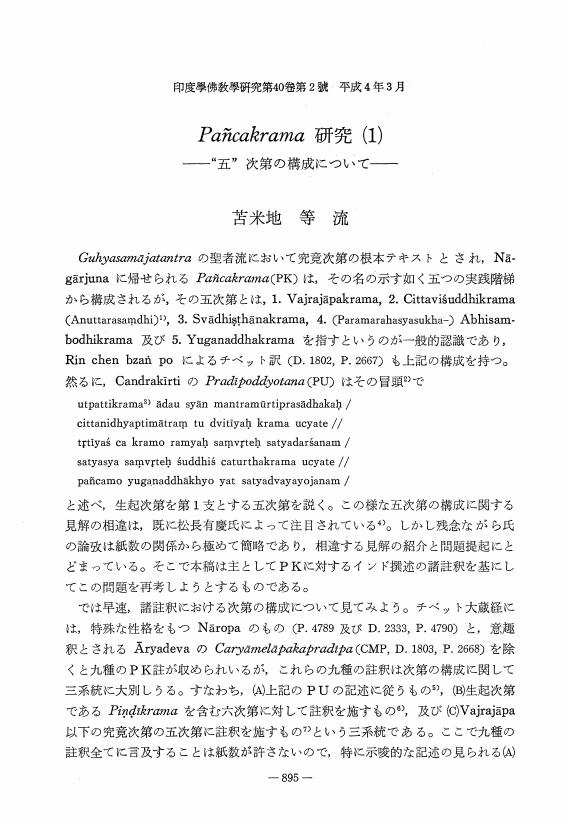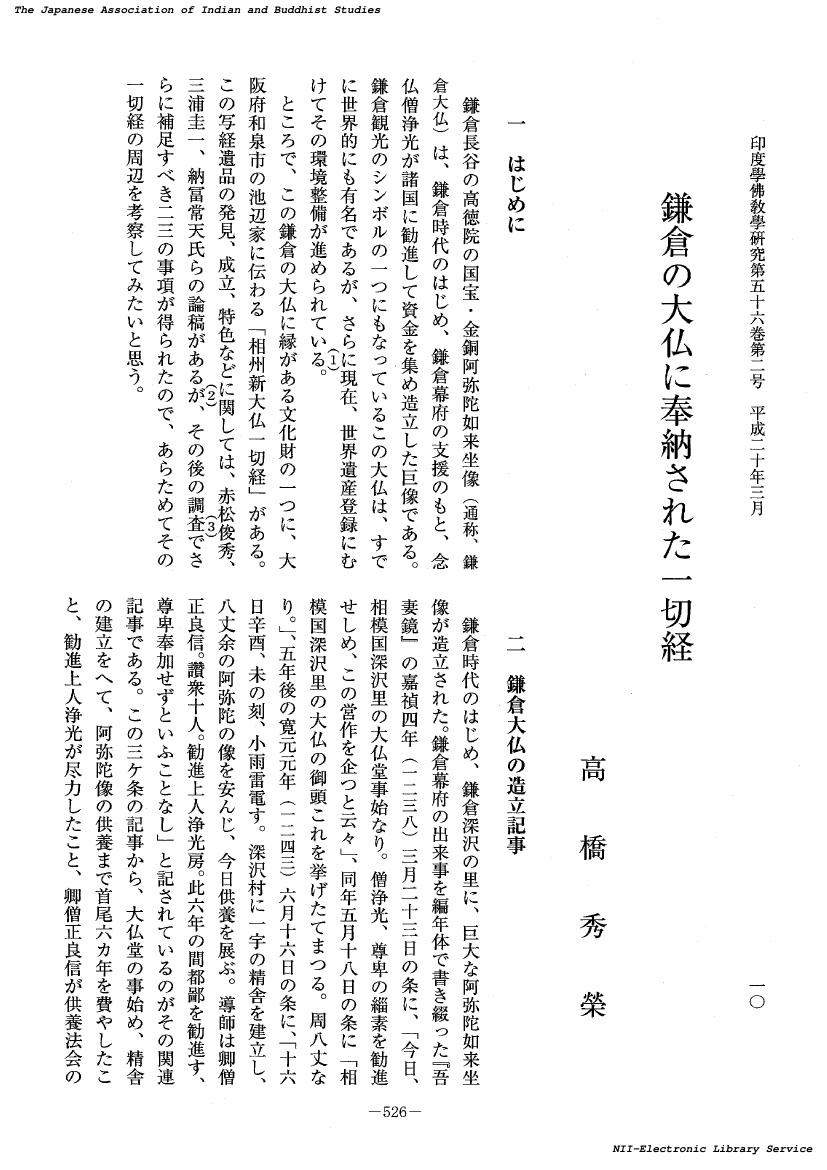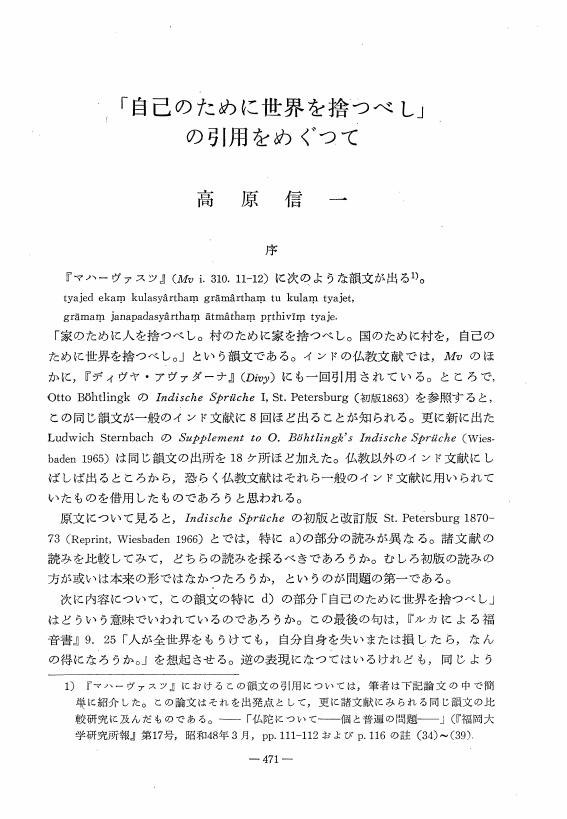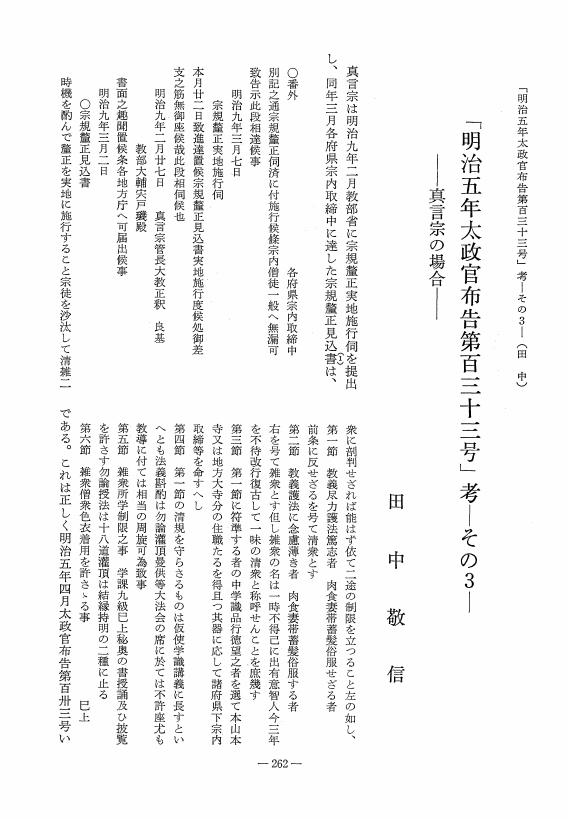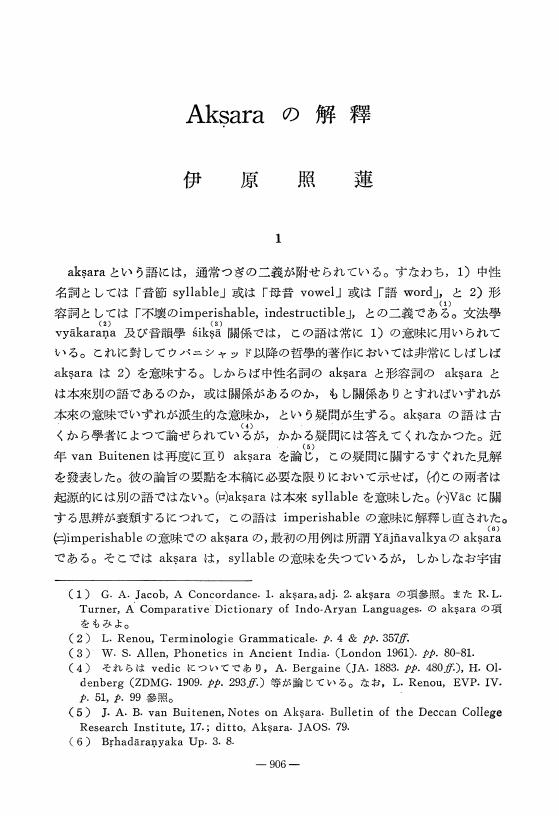1 0 0 0 OA 陰陽道祭文と修験道祭文 -牛頭天王祭文を例として-
- 著者
- 岩佐 貫三
- 出版者
- Japanese Association of Indian and Buddhist Studies
- 雑誌
- 印度學佛教學研究 (ISSN:00194344)
- 巻号頁・発行日
- vol.23, no.1, pp.317-321, 1974-12-25 (Released:2010-03-09)
1 0 0 0 OA 近代日蓮宗における「充洽園教学」の意義
- 著者
- 小野 文〓
- 出版者
- Japanese Association of Indian and Buddhist Studies
- 雑誌
- 印度學佛教學研究 (ISSN:00194344)
- 巻号頁・発行日
- vol.35, no.1, pp.233-238, 1986-12-25 (Released:2010-03-09)
1 0 0 0 OA 島地黙雷の神道観
- 著者
- 野世 英水
- 出版者
- Japanese Association of Indian and Buddhist Studies
- 雑誌
- 印度學佛教學研究 (ISSN:00194344)
- 巻号頁・発行日
- vol.43, no.1, pp.184-188, 1994-12-20 (Released:2010-03-09)
1 0 0 0 OA 最澄の小戒棄捨について
- 著者
- 蓑輪 顕量
- 出版者
- Japanese Association of Indian and Buddhist Studies
- 雑誌
- 印度學佛教學研究 (ISSN:00194344)
- 巻号頁・発行日
- vol.36, no.1, pp.127-130, 1987-12-25 (Released:2010-03-09)
1 0 0 0 OA Pañcakrama 研究 (1)
- 著者
- 苫米地 等流
- 出版者
- Japanese Association of Indian and Buddhist Studies
- 雑誌
- 印度學佛教學研究 (ISSN:00194344)
- 巻号頁・発行日
- vol.40, no.2, pp.895-892, 1992-03-20 (Released:2010-03-09)
1 0 0 0 OA 四天の邪鬼と方相鬼 -鬼の思想研究・その三-
- 著者
- 岩佐 貫三
- 出版者
- Japanese Association of Indian and Buddhist Studies
- 雑誌
- 印度學佛教學研究 (ISSN:00194344)
- 巻号頁・発行日
- vol.25, no.1, pp.387-390, 1976-12-25 (Released:2010-03-09)
1 0 0 0 OA 法天訳『最上大乘金剛大教寶王經』と『秘密集会タントラ』聖者流
- 著者
- 苫米地 等流
- 出版者
- 日本印度学仏教学会
- 雑誌
- 印度學佛教學研究 (ISSN:00194344)
- 巻号頁・発行日
- vol.61, no.1, pp.406-401, 2012-12-20 (Released:2017-09-01)
1 0 0 0 OA 中世曹洞宗と霊山信仰
- 著者
- 石川 力山
- 出版者
- Japanese Association of Indian and Buddhist Studies
- 雑誌
- 印度學佛教學研究 (ISSN:00194344)
- 巻号頁・発行日
- vol.33, no.2, pp.441-446, 1985-03-25 (Released:2010-03-09)
1 0 0 0 OA 中世曹洞宗の地方展開と源翁心昭
- 著者
- 石川 力山
- 出版者
- Japanese Association of Indian and Buddhist Studies
- 雑誌
- 印度學佛教學研究 (ISSN:00194344)
- 巻号頁・発行日
- vol.31, no.1, pp.227-231, 1982-12-25 (Released:2010-03-09)
1 0 0 0 OA 偽作の法句経と疏の異本について
- 著者
- 田中 良昭
- 出版者
- Japanese Association of Indian and Buddhist Studies
- 雑誌
- 印度學佛教學研究 (ISSN:00194344)
- 巻号頁・発行日
- vol.23, no.1, pp.122-129, 1974-12-25 (Released:2010-03-09)
1 0 0 0 OA 鎌倉の大仏に奉納された一切経
- 著者
- 高橋 秀榮
- 出版者
- 日本印度学仏教学会
- 雑誌
- 印度學佛教學研究 (ISSN:00194344)
- 巻号頁・発行日
- vol.56, no.2, pp.526-533, 2008-03-20 (Released:2017-09-01)
1 0 0 0 OA ソービタ長老釈仁度和上招来の貝多羅葉について
- 著者
- 東元 慶喜
- 出版者
- Japanese Association of Indian and Buddhist Studies
- 雑誌
- 印度學佛教學研究 (ISSN:00194344)
- 巻号頁・発行日
- vol.31, no.2, pp.486-492, 1983-03-25 (Released:2010-03-09)
1 0 0 0 OA 「自己のために世界を捨つべし」の引用をめぐって
- 著者
- 高原 信一
- 出版者
- Japanese Association of Indian and Buddhist Studies
- 雑誌
- 印度學佛教學研究 (ISSN:00194344)
- 巻号頁・発行日
- vol.22, no.1, pp.471-461, 1973-12-31 (Released:2010-03-09)
1 0 0 0 OA 広蔵院日辰の先師批判について
- 著者
- 田村 完爾
- 出版者
- Japanese Association of Indian and Buddhist Studies
- 雑誌
- 印度學佛教學研究 (ISSN:00194344)
- 巻号頁・発行日
- vol.45, no.1, pp.237-239, 1996-12-20 (Released:2010-03-09)
1 0 0 0 OA 「明治五年太政官布告第百三十三号」考 -その3- -真言宗の場合-
- 著者
- 田中 敬信
- 出版者
- Japanese Association of Indian and Buddhist Studies
- 雑誌
- 印度學佛教學研究 (ISSN:00194344)
- 巻号頁・発行日
- vol.33, no.1, pp.262-265, 1984-12-25 (Released:2010-03-09)
1 0 0 0 OA 広蔵院日辰の本迹論に関する一考察――序品題号の「妙法」をめぐって――
- 著者
- 神田 大輝
- 出版者
- 日本印度学仏教学会
- 雑誌
- 印度學佛教學研究 (ISSN:00194344)
- 巻号頁・発行日
- vol.68, no.2, pp.670-675, 2020-03-20 (Released:2020-09-10)
- 参考文献数
- 3
In relation to the various religious doctrines which became diversified after the death of Nichiren (日蓮), the viewpoint of Honjaku theory (本迹論) is the most important index to examine the characteristics of the disciples. Kōzōin Nisshin (広蔵院日辰, mid-16th c.), who was based in Kyoto during the Sengoku Period, was a notable learned priest who established a major theoretical system of the Honjaku theory. Nisshin discriminated between Honmon (本門) and Shakumon (迹門). The distinctive feature of the theory is that it discusses the superiority of “Chapter 16, Nyorai Juryō-hon (如来寿量品第十六)” out of the 28 chapters of the Lotus Sūtra. In this paper, in order to clarify the characteristics of the Honjaku theory of Nisshin, I compare it with the theory of the Icchi school (一致派) priests who discussed the unity of the Honmon and Shakumon. I took up as my starting point the contention shared by the learned priests of the Shoretsu (勝劣) and Icchi schools, that is, the interpretation of “Myōhō 妙法” in the first introductory chapter. The teachings of the abovementioned priests strongly reflect the characteristics of the doctrines that they upheld. Here I point out that Nisshin interprets this “Myōhō” of the title of the introductory chapter based on the sixteenth chapter.
1 0 0 0 OA Aksara の解釋
- 著者
- 伊原 照蓮
- 出版者
- Japanese Association of Indian and Buddhist Studies
- 雑誌
- 印度學佛教學研究 (ISSN:00194344)
- 巻号頁・発行日
- vol.15, no.2, pp.906-901, 1967-03-31 (Released:2010-03-09)
1 0 0 0 OA 『五輪九字明秘密釈』の書写系統をめぐる問題
- 著者
- 赤塚 祐道
- 出版者
- 日本印度学仏教学会
- 雑誌
- 印度學佛教學研究 (ISSN:00194344)
- 巻号頁・発行日
- vol.68, no.2, pp.713-718, 2020-03-20 (Released:2020-09-10)
- 参考文献数
- 2
Studies of Kakuban (覚鑁, 1095–1143) are based on the Kōgyō Daishi zenshū (興教大師全集). However, regarding Kakuban’s representative work, the Gorin kujimyō himitsushaku (五輪九字明秘密釈), a comparison of the Kōgyō Daishi zenshū text with various other sources reveals differences in words and phrases. A comparison of the manuscript and printed editions shows that the following classification can be made: (1) the Hokekyō-ji and Shōmyō-ji texts, (2) the Ninna-ji text and the Buzan Mitsugon shohishaku printed text, (3) the Chisan Mitsugon shohishaku printed text and the Kōgyō Daishi zenshū text, and (4) other manuscripts.In group (1), the Hokekyō-ji text (copied 1251) and the Shōmyō-ji text (copied 1254) are in agreement in their attached annotations, obverse annotations, verses, and lacunas. They are clearly in the same lineage. In group (2), the Ninna-ji text (copied 1308) and Buzan printed text (published around 1690) are alike in their okurigana and words and phrases. They are chronologically separated, but the two texts are in a close relationship.For group (3), the Chisan text is a revision of the Buzan text, with corrections in the Chinese word order and illustrations added. The Kōgyō Daishi zenshū text was edited with reference to the words and phrases and illustrations in the Chisan text. The texts in group (4), including the former Kanchi-in text, the Zuishin-in text, the colored Shōmyō-ji text, the Hōki-in text, and others do not belong to groups (1) and (3), and with the exception of the okurigana are close to (2) the Ninna-ji text.As explained above, the manuscripts of the Gorin kujimyō himitsushaku fall into four groups. From this it will be noted that the Kōgyō Daishi zenshū text does not necessarily transmit the content of all the preceding manuscripts.
1 0 0 0 OA 釈尊の葬儀について
- 著者
- 宇治 谷顕
- 出版者
- Japanese Association of Indian and Buddhist Studies
- 雑誌
- 印度學佛教學研究 (ISSN:00194344)
- 巻号頁・発行日
- vol.30, no.2, pp.956-953, 1982-03-31 (Released:2010-03-09)
1 0 0 0 OA 『金剛般若経』霊験記類について
- 著者
- 勝崎 裕彦
- 出版者
- Japanese Association of Indian and Buddhist Studies
- 雑誌
- 印度學佛教學研究 (ISSN:00194344)
- 巻号頁・発行日
- vol.40, no.1, pp.85-89, 1991-12-20 (Released:2010-03-09)




